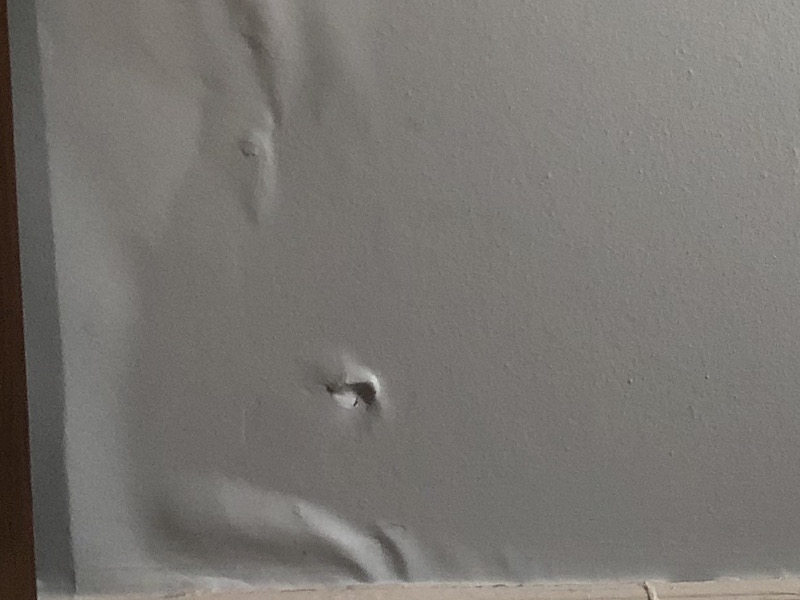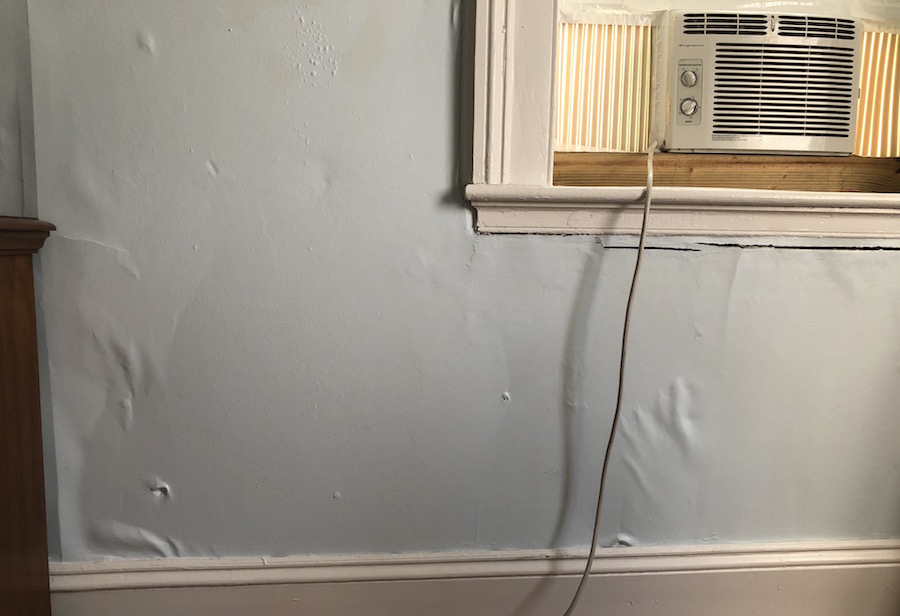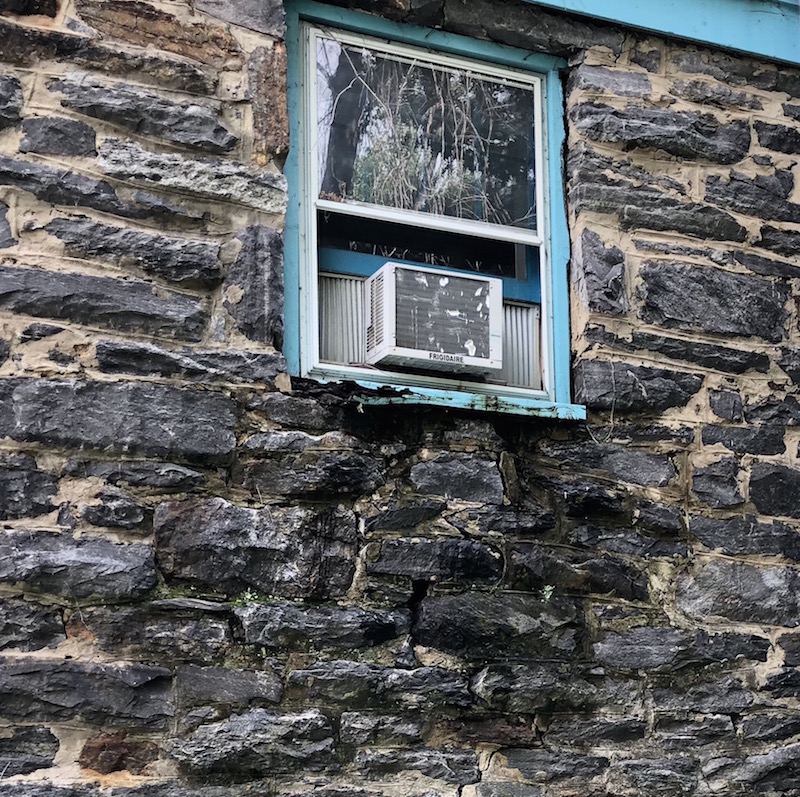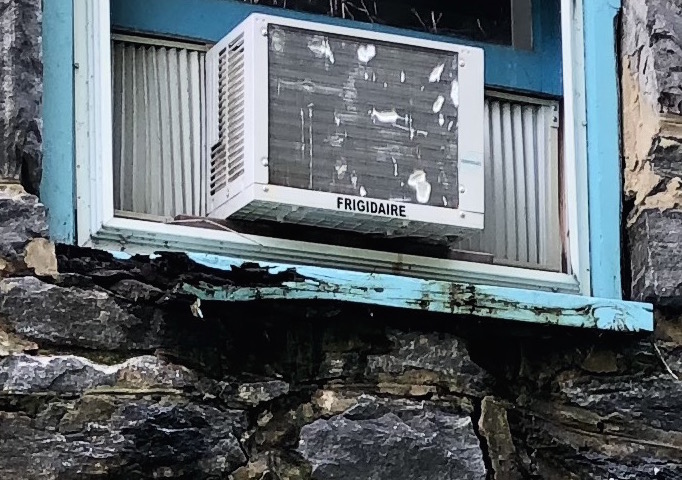A Moisture Mystery Anyone Could Solve

Last weekend my wife and I went to Asheville, North Carolina to hear Lyle Lovett and His Large Band at the Biltmore Estate. It was a wonderful evening! Mountains, sunset, gardens… We even had four planets lined up over the stage: Mars, Saturn, Jupiter, and Venus.
While in Asheville, we spent the night in a room we found on VRBO (Vacation Rentals By Owner). When we got into the room, one wall in the bedroom caught my eye. Here’s a section of it:

Of course I had to touch it. It was soft and spongy. That hole you see near the baseboard was there when I arrived, but I really did want to rip that drywall away from the studs…at the very end of my stay anyway. Although I didn’t detect any mildewy smell, I suspected the other side of that drywall was in full bloom with some nasty microbial infestations.
Clearly, that drywall was full of water. But how did it get wet?
Stepping back a little, I scanned the whole wall. Aha! A window air conditioner.

A couple of hypotheses suggested themselves to me. That little AC was keeping the room quite chilly, which means the drywall was chilly, too. The fundamental rule of material wetness, as stated by Bill Rose in his excellent book, Water in Buildings, is that cold materials tend to be wet and warm materials tend to be dry.
My first hypothesis was that the outer part of that wall was connected to the ground and the cold wall was sucking water up through capillary action. It’s certainly a reasonable hypothesis.
My second hypothesis was more exciting. Maybe, I thought, outdoor air is getting into that cavity and water vapor from the humid air was adsorbing onto all the surfaces of the porous drywall. The dew point in Asheville was around 70° F, so the moisture is there.
That hypothesis was more exciting because liquid water problems are so common. Plus, if it’s water vapor, we can talk about phase changes and psychrometrics.
Alas, when I went outdoors, I found that neither of those two hypotheses was correct. Do you see what’s going on here?

This is a simple problem of the condensate from the air conditioner getting dumped out onto the window sill and getting into everything. The stone below is saturated. The sill is rotten. And I’m sure some of that condensate is draining into the cavity on the other side of the stone, which is how it’s getting into that spongy drywall.

The problem here is easy to solve. It wouldn’t be hard to see what’s happening. It wouldn’t be hard to have avoided it. If they had only run a condensate drain down to the ground, that sill would be fine and the drywall probably would be dry. Of course, there’s still a chance that water vapor from outdoor air is playing a role, but the other walls in that chilly room were fine.
Sometimes you can solve moisture problems without knowing the definition of “hygroscopic” or how to use a psychrometric chart or why the sorption isotherms for stone and drywall are different. Sometimes you just need to look at the evidence in front of you. As Yogi Berra said, “You can observe a lot by just watching.”
Related Articles
Solving a Crawl Space Water Mystery
4 Ways Moisture Enters a Vented Crawl Space
What’s Causing the Moisture Problem in This Trendy Restaurant?
NOTE: Comments are moderated. Your comment will not appear below until approved.
This Post Has 11 Comments
Comments are closed.

Thanks Allison! Very nice
Thanks Allison! Very nice that you got to see Lyle Lovett at the Biltmore Estate. I saw a show there once and it really is a beautiful setting.
I also live in an old house in Asheville – we rent it. And when we first moved in we found water damage – the landlord “fixed” it – and when they pulled away the interior plaster board there was NO INSULATION. Apparently this is common for old houses here (ours was built around 1949 or 1950). I’m sure that only increases the chances of the interior wall falling below the dew point.
Great post, Allison. Agree —
Great post, Allison. Agree — sometimes, you just have to look at the evidence.
A factoid I gleaned from some
A factoid I gleaned from some building guys who talk publicly around here (i.e. Houston Texas)… old style construction had no insulation, which had the benefit that water leaks would quickly dry out.
Adding insulation meant adding a host of other problems to fight. I’m still searching for how to have foam insulation at the roof decking while guaranteeing it won’t create rot in a hot-humid climate.
Two steps forward, one step back.
What?!? Solving a building
What?!? Solving a building durability problem without a WUFI model and reference to the psychedelic chart? Blasphemy!
Praise the mini-split for this kind of application, and if that’s not economically practical even the little stand-alone room ACs with the duct out and in through the window opening would be better.
I hope the owner was receptive to your suggestions for improvement and repair. I’ll bet they had no idea the value of your advise. Priceless!
Mac, minisplits and portable
Mac, minisplits and portable units have condensate drains that can plug up and cause problems too.
Bought a house 8 years ago
Bought a house 8 years ago that has 2 roof power vents. One vent stopped working and was told because attic has no other source of venting, needed to replace the power vents ( wish I had found your article). The power vents were replaced with more powerful ones that move a greater amount of air. I am now having problems with my central air and very high humidity levels in the house. I am uneducated on roof ventilation-thought I was doing the right thing but now fear that my central air/humidity problem is due to the power vents. I have a HVAC repair tech coming and as an experiment turned off the power vents to see what happens. My roof is very pitched with the back slanting.Do not know if I have adequate space for ridge vents if I removed and repaired power vent holes. If I can do ridge venting and have to wait for a roof company to do the work is it ok not to have any ventilation while I wait. I am at a loss as what to do.
E, if you search this site
E, if you search this site (and greenbuildingadvisor.com) you will find sorm stories about powered roof ventilators.
The short answer is the powered attic fan is pulling the conditioned air out of your house and into the attic through the cracks and holes between them. That air is replaced by hot moist outside air leaking into your house. Turn off the attic fans and leave them off. Everyone who tells you not to do this (most people) is wrong. For more info see the articles.
Do you really think that this
Do you really think that this window unit had a condensate drain? A lot of them have a sling ring on the condenser fan that throws the condensate onto the condenser coil (or through it). I am guessing that the condensate drain path from the evaporator to the condenser fan got plugged or the unit is not level.
After working on houses and
After working on houses and doing repairs for years, I have found a lot of people tend to lack spacial awareness. Many times I will go to properties to look at one item and I leave giving them a whole list of things they didn’t realize were wrong
Does wall orientation allow
Does wall orientation allow solar moisture drive to wet wall interior?
Thank you for the article and
Thank you for the article and pictures of the found conditions. I would like to see some information on the overall building. Is it possible to see the entire elevation of the wall.
I see in the rotted wood sill that this is not a solid masonry wall construction. I suspect it is an applied stone veneer and as such. It has no evidence of flashings, installed working weep holes, nor a drainage plane or associated space between frame construction and the exterior masonry. My personal experience with such stick-on stone veneers has always been they are trouble. They leak by way of the many holes in setting the stones and other poor joints in the installation.
This is a long existing condition and may vary well dangerous to renters of the building. But that is another article.
As for fixing the issues it requires in depth inspection and a willingness to solve the conditions regardless of the cost.